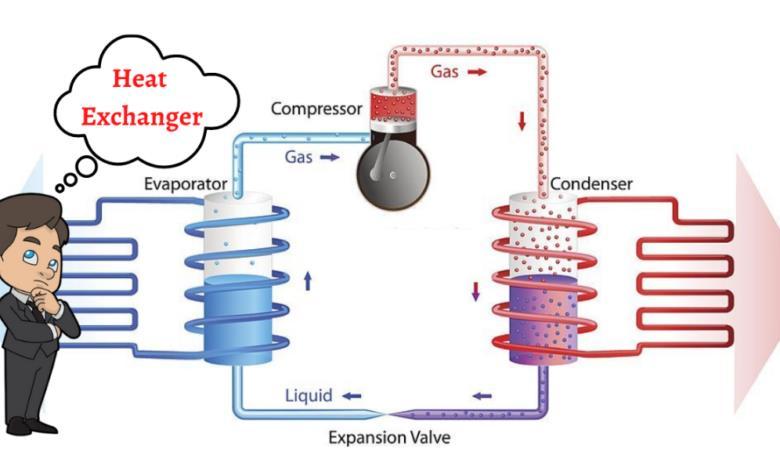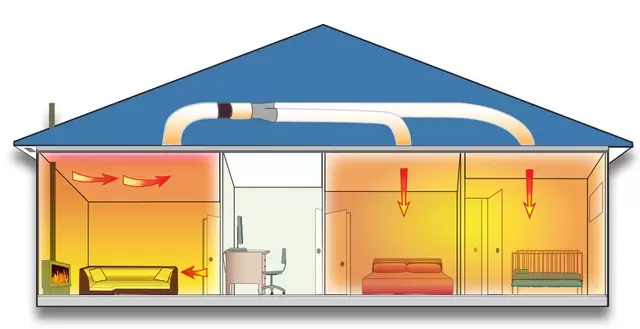Can DVS Heat Transfer Systems Help You Achieve Environmental Compliance Standards?
Wiki Article
A Comprehensive Overview to Selecting the Right Heat Transfer Systems for Your Needs
Selecting the proper Heat transfer system is vital for operational performance. Different systems deal with various demands, influenced by elements such as temperature level variety and liquid kind. Comprehending the concepts behind Heat transfer, such as convection, transmission, and radiation, is vital. Furthermore, evaluating power sources and upkeep techniques can influence long-term performance. A closer evaluation of these considerations reveals just how to tailor a system to details needs. What should one prioritize in this complicated decision-making process?Understanding Heat Transfer: Secret Ideas and Concepts
Heat transfer might seem like a simple concept, it encompasses a range of principles that are fundamental for efficient system design - DVS Heat Transfer Systems. Comprehending these principles is necessary for designers and engineers that intend to optimize thermal efficiency in different applications. Transmission, for example, includes the transfer of Heat with solid products, while convection refers to the movement of Heat within liquids. Radiation, another crucial concept, defines exactly how Heat can be moved with electromagnetic waves. Each of these mechanisms plays an essential function in figuring out how energy relocates within a system. By extensively grasping these principles, experts can make informed decisions, guaranteeing that Heat transfer systems run efficiently and meet the certain demands of their applications
Sorts Of Heat Transfer Solutions: A Review
Recognizing the concepts of Heat transfer lays the foundation for discovering the different kinds of Heat transfer systems available. Heat transfer systems can be classified mostly right into three types: convection, conduction, and radiation. Transmission involves Heat transfer through solid materials, relying upon direct get in touch with in between particles. Convection, on the various other hand, takes place in fluids (fluids and gases) where the motion of the fluid itself facilitates Heat transfer. Radiation entails the transfer of Heat through electromagnetic waves and does not require a tool, enabling it to occur in a vacuum cleaner. Each kind of system has distinct attributes and applications, making it important for people and companies to meticulously analyze their particular demands when selecting one of the most ideal Heat transfer option.Applications of Heat Transfer Solutions in Various Industries
Heat transfer systems play an important role across various sectors, impacting efficiency and product top quality. In industrial manufacturing procedures, they assist in specific temperature level control, while in food and beverage processing, they ensure safety and security and preservation. In addition, heating and cooling and environment control systems depend heavily on effective Heat transfer to maintain comfortable settings.Industrial Production Processes

Numerous commercial production procedures depend heavily on efficient Heat transfer systems to maximize efficiency and enhance item top quality. In sectors such as metalworking, Heat exchangers play an essential duty in keeping excellent temperature levels during welding, spreading, and creating. These systems guarantee uniform Heat circulation, which is crucial for attaining preferred material buildings. Likewise, in the chemical production industry, Heat transfer systems promote exact temperature level control throughout responses, impacting return and safety and security. In fabric manufacturing, reliable Heat administration is essential for dyeing and finishing processes, influencing shade consistency and textile high quality. By picking proper Heat transfer innovations, suppliers can improve energy performance and minimize functional expenses, eventually causing a much more affordable and sustainable production atmosphere.
Food and Drink Processing
Effective Heat transfer systems are similarly crucial in the food and beverage processing market, where maintaining optimal temperatures is vital for food safety and high quality. These systems play a necessary role in processes such as sanitation, pasteurization, and cooking, making sure that products are safe for usage and keep their dietary value. Heat exchangers, for example, successfully move Heat in between liquids, enhancing power use while lessening temperature level variations. In addition, refrigeration systems are essential for expanding and maintaining subject to spoiling items shelf life. The selection of Heat transfer innovation directly affects functional performance and product honesty, making it vital for food and drink makers to select the appropriate systems tailored to their certain processing needs. This careful option ultimately adds to customer contentment and food safety.
HVAC and Climate Control
While several markets count on Heat transfer systems for performance, HVAC (Heating, Air Flow, and A/c) plays an important function in keeping indoor environment control throughout numerous setups. These systems make use of Heat transfer concepts to control air, temperature, and moisture top quality, making certain comfort and safety in residential, business, and commercial atmospheres. Properly made heating and cooling systems enhance energy efficiency, lower operational expenses, and minimize environmental impact. In commercial buildings, for instance, effective environment control adds to worker performance and client contentment. In commercial applications, a/c systems assist preserve suitable conditions for devices procedure and item important source conservation. Selecting the appropriate Heat transfer system is important for conference certain climate control needs and achieving total system performance.Reviewing Power Sources for Heat Transfer Equipments
In examining power resources for Heat transfer systems, a comparison of renewable resource alternatives and fossil gas factors to consider is essential. Sustainable resources, such as solar and wind, offer lasting choices that can minimize ecological influence. On the other hand, fossil fuels remain widespread due to their recognized infrastructure and power thickness, motivating a mindful assessment of both options.Renewable Resource Options

Nonrenewable Fuel Source Considerations
Reviewing fossil fuel factors to consider is vital for the performance and sustainability of Heat transfer systems. Fossil fuels, such as gas, oil, and coal, are typical energy resources that provide substantial Heat result, making them popular selections for industrial and household applications. Their environmental impact, including greenhouse gas exhausts and resource exhaustion, elevates problems. When selecting a heat transfer system, it is important to evaluate the accessibility, cost, and governing aspects connected with these fuels. Additionally, the performance of nonrenewable fuel source systems have to be considered, as greater effectiveness can minimize some environmental disadvantages. Inevitably, a balanced method evaluating performance and sustainability can direct decision-makers towards one of the most appropriate Heat transfer option for their specific demands.Elements to Consider When Selecting a Warm Transfer System
Choosing an appropriate Heat transfer system needs careful factor to consider of various variables that can significantly influence performance and efficiency. One vital factor is the operating temperature level range, which dictates the products and layout appropriate for the application. Additionally, the sort of fluid used in the system-- whether gas or liquid-- affects Heat transfer efficiency and compatibility. The system's dimension and capability must straighten with the certain demands of the procedure to stay clear of inefficiencies. Power resource accessibility is also important, influencing operating prices and sustainability. The installment setting, including area restrictions and availability for upkeep, plays a substantial role in system option. Lastly, regulatory compliance and safety and security criteria need to be thought about to assure the system meets all lawful requirements.Upkeep and Performance Optimization for Heat Transfer Equipments
Keeping Heat transfer systems is vital for ensuring optimal efficiency and longevity. Regular maintenance activities, such as cleaning Heat exchangers and inspecting insulation, assistance stop performance losses as a result of fouling and thermal bridging. In addition, keeping an eye on system parameters, consisting of stress and temperature, permits very early detection of anomalies, minimizing downtime and costly fixings. Applying a preventative maintenance timetable can enhance efficiency and extend the life-span of components. Moreover, updating to advanced control systems can boost functional efficiency by getting used to differing problems and tons. By focusing on maintenance and performance optimization, operators can accomplish reduced energy usage, lower operational costs, and improved overall system integrity, inevitably resulting in better resource application and a much more lasting operation.Future Fads in Heat Transfer Technologies
As sectors progressively focus on sustainability and power effectiveness, future fads in Heat transfer innovations are my company readied to go through considerable makeovers. Developments such as innovative products, including try this web-site carbon nanotubes and nanofluids, guarantee improved thermal conductivity and efficiency. Additionally, the combination of eco-friendly energy resources right into Heat transfer systems is gaining energy, promoting environmentally friendly options. Smart innovations, consisting of IoT sensing units, are anticipated to change tracking and control, allowing real-time information analysis for optimized efficiency. The growth of modular and compact systems will certainly help with much easier setup and upkeep, catering to diverse applications. These developments indicate a change in the direction of even more lasting, effective, and versatile Heat transfer remedies, lining up with worldwide power objectives and environmental standards.
Frequently Asked Concerns
What Are the Ecological Impacts of Heat Transfer Equipments?
The ecological effects of Heat transfer systems can consist of greenhouse gas discharges, energy intake, and prospective thermal contamination. Additionally, improper disposal of materials and inadequacies can contribute to resource deficiency and community interruption.Just how Do I Calculate the Cost-Effectiveness of a Warm Transfer System?
To compute the cost-effectiveness of a heat transfer system, one should assess first expenses, operational expenses, upkeep demands, and energy performance, comparing these elements versus the anticipated life expectancy and performance of the system.Can Heat Transfer Systems Be Utilized in Residential Settings?
Heat transfer systems can certainly be used in residential settings. They supply effective heating and cooling down remedies, making homes much more comfortable while potentially decreasing energy prices. Their adaptability enables various applications in property settings.What Safety Regulations Put On Heat Transfer Equipments?
Safety and security policies for Heat transfer systems usually include guidelines on maintenance, operation, and setup. Conformity with local building regulations, maker specifications, and industry criteria is vital to ensure risk-free and effective system efficiency in various applications.Just How Do Various Materials Affect Heat Transfer Performance?

Transmission, for instance, involves the transfer of Heat via strong products, while convection refers to the movement of Heat within liquids. Recognizing the concepts of Heat transfer lays the foundation for checking out the various types of Heat transfer systems offered. Heat exchangers, for instance, efficiently move Heat in between fluids, optimizing power use while minimizing temperature changes. In reviewing power resources for Heat transfer systems, a contrast of renewable energy alternatives and fossil gas factors to consider is crucial. Steels, such as copper and light weight aluminum, conduct Heat properly, whereas insulators like rubber and glass reduce down Heat circulation.
Report this wiki page